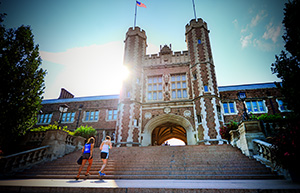
As the cost of higher education continues to climb steadily across the country and around the world, Washington University in St. Louis is firmly committed to being within financial reach of all highly qualified students, and is taking two important steps toward this goal.
Lowest percentage tuition increase in 47 years
The cost of undergraduate tuition for the 2015-16 academic year will be $47,300, an increase of $1,600 over the 2014-15 tuition rate. Although tuition is going up, the 3.5-percent increase represents the lowest percentage of an annual tuition increase at the university since 1968.
“Our three key goals at Washington University continue to be ensuring a top-quality education, attracting a diverse student body, and making it affordable to attend. All three are equally important and on all fronts we continue to make progress,” said Chancellor Mark S. Wrighton. “As our operating expenses increase each year with customary growth and inflation, we also are constantly working to implement cost-saving measures and shift priorities to allow for the lowest possible increases in tuition.”
Commitment to socio-economic diversity
In addition to keeping tuition increases at a minimum, the university also remains committed to improving the diversity of its student body. As part of its ongoing effort to attract and retain highly talented low-income students, the university is aiming for a significant, specific increase in the percentage of first-time, full-time students enrolled at the university who are eligible for the Federal Pell Grant Program, which is one important indicator of economic diversity.
The percentage of Pell-eligible students in the 2014-15 freshman class has grown in recent years to 8 percent, from 6 percent in 2013-14 and 5 percent in 2012-13. Wrighton has set a goal of increasing that figure incrementally every year to 13 percent for the 2020-21 freshman class. This will be accomplished through a variety of fundraising and cost-saving measures, as well as reallocations of funds within the university’s operating budget to support need-based financial aid. To reach the goal, the university will dedicate at least $25 million annually. Already, the university has committed $75 million in new endowment funds for this purpose.
“Improving the socio-economic diversity of our student body is not just important; it’s critical to our success as a university,” said Provost Holden Thorp, PhD, executive vice chancellor for academic affairs and the Rita Levi-Montalcini Distinguished University Professor. “We’re pleased to be making some progress, but we’re in this for the long haul. Our initial goal of 13 percent Pell-eligible by 2020 is not only ambitious, but, I believe, fully attainable. And it is only the beginning.”
Other information about 2015-16 tuition and fees
The required student activity fee for 2015-16 will total $473. The health and wellness fee will be $320.
Charges for on-campus double-occupancy housing for 2015-16 will range between $9,482 and $10,486, depending on housing type selected, and meal plans for 2015-16 will range from $4,014 to $5,576.
Students who qualify for need-based financial assistance will receive consideration for the cost increases, along with consideration of changes in their family financial circumstances.
Below are the 2015-16 full-time tuition and fee schedules for the university’s graduate and professional programs as well as tuition for evening and summer schools enrolling part-time students.
Graduate and professional tuition, 2015-16
Graduate School of Arts & Sciences and graduate programs in the School of Engineering & Applied Science: The 2015-16 tuition charge for graduate students in these programs will be $47,300, an increase of $1,600 (3.5 percent).
Graduate School of Architecture & Urban Design: The 2015-16 tuition charge for the Master of Architecture program will be $46,850, an increase of $1,370 (3 percent).
Graduate School of Art: The 2015-16 tuition charge for the Master of Fine Arts program will be $38,480, an increase of $1,300 (3.5 percent).
Brown School: The 2015-16 tuition charge for the Master of Social Work program will be $38,234, an increase of $1,364 (3.7 percent), and the Master in Public Health will be $33,132, an increase of $1,182 (3.7 percent).
Olin Business School graduate program: The 2015-16 tuition for the Master of Business Administration program will be $53,500, an increase of $2,000 (3.9 percent).
School of Law and School of Medicine: Tuition for 2015-16 for the Juris Doctor, LLM program and Doctor of Medicine degree will be announced this spring.
Evening and Summer School tuition rates, 2015-16
Undergraduate evening students: For undergraduate evening students enrolling in University College in Arts & Sciences or continuing education classes in the School of Architecture in 2015-16, tuition will be $640 per credit hour.
Graduate students in University College: Depending upon the graduate program in University College in Arts & Sciences, tuition will range from $640 to $995 per credit hour for 2015-16.
Summer School in Arts & Sciences: Tuition in Summer School classes in Arts & Sciences will be $1,060 per undergraduate credit hour and $1,260 graduate credit hour for summer 2015.